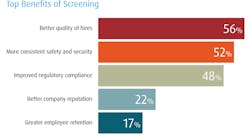Survey shines light on background screening priorities in higher education
Given the emphasis that’s placed on security at colleges and universities across the U.S., one of the simplest and most important aspects of safeguarding a campus begins with performing background checks on faculty and staff members. However, the types of background checks performed by schools on prospective employees varies between institutions.
Employment screening services firm HireRight recently released the results of its “Employment Background Checks in Education” report, which surveyed personnel with knowledge of HR policies and procedures at 197 schools. Of the colleges and universities surveyed, 77 percent had 500 or more employees and nearly one-third had more than 4,000 employees.
The report, which is the company’s first on employment screening practices in the higher education market, found that 96 percent of the schools surveyed conducted criminal background checks, while 73 percent indicated that they performed identity verifications. Other background checks performed by schools in the study included education (54 percent), previous employment/references (51 percent), motor vehicle records (47 percent), credit history (38 percent), professional license verifications (30 percent), fingerprints (16 percent), and re-verifying current employees (14 percent).
According to Rachel Trindade, vice president of marketing at HireRight, while the higher education market seemed to have a “comprehensive package” of background checks that they conducted overall, there were a few surprises. For example, she said that employment verification by colleges and universities was about 20 percent lower compared to other types of organizations studied. Additionally, Trindade said that only about 15 percent of higher education institutions surveyed reported performing drug screening of employees versus 58 percent of organizations in the general population that perform them.
“What actually was pretty impressive about this study was that higher education did seem to have some pretty good core packages,” said Trindade. “What’s really interesting that’s not in this report are things that we hear from speaking to prospective clients and that is the differentiation between faculty and staff. There is very high adoption of screening (procedures) for staff, but when it comes to their faculty, there is somewhat of a shift that is happening now because historically, they haven’t always been screened and it wasn’t always necessarily accepted. However, we’re starting to see that come up more and more in conversations with universities now.”
Trindade added that the background screening process is still very new to some schools, some of whom may not have had the chance to roll out a more comprehensive program. This could account for some of the discrepancies in checks performed by higher education institutions versus other sectors. That’s not to say, however that colleges and universities don’t see the benefits in screening their employees. In fact, 59 percent of those surveyed said that the top benefit of screening was that it provided more consistent safety and security. Other benefits of screening reported by schools include improved regulatory compliance (43 percent), better quality of hires (35 percent), better reputation of the institution (14 percent), and greater employee retention (six percent).
More than three-quarters of respondents (77 percent) said that the screening process had uncovered a person who lied on their resume or application. Trindade said that this is actually lower the rest of the general population, 88 percent of whom indicated that they had uncovered deception. Another 63 percent of schools said that background screening uncovered issues that would not have otherwise been found about an applicant.
Another area where higher education really stood out compared to the other organizations was in conducting I-9 employment eligibility verification. According to Trindade, about 36 percent of higher education institutions do a digital, fully comprehensive I-9 process whereas only about 19 percent of the general population does so.
While, colleges may be doing a good job overall of vetting employees, there are still several things that they could be doing better, such as screening their non-employee workforce – temporary workers, contractors and vendors – who are going to be doing work on campus, according to Trindade.
“Some of the areas where they can improve is reviewing their policies annually,” said Trindade. “We find that there are a lot of organizations who haven’t reviewed their policies or haven’t implemented a (background screening) program. For those that have implemented a program – as things continue to evolve from a campus safety standpoint – they should really be reviewing some of those policies annually. And also just making sure that they do the right types of checks for each position. Employees who are involved in fundraising and budgets, they might require more in-depth background checks or credit checks and even high-profile employees (i.e. basketball or football coaches) may require a more comprehensive background report.”
Based on the results of the survey, many schools are planning to beef up their screening procedures. When asked about planned changes for this year, 47 percent of respondents said they intend to improve general background screening policies and procedures. Another 28 percent said they are going to improve employment eligibility (I-9) screening and 22 percent indicated that they plan to integrate background screening with a talent management solution.
Click here for more information or to download the full report.




